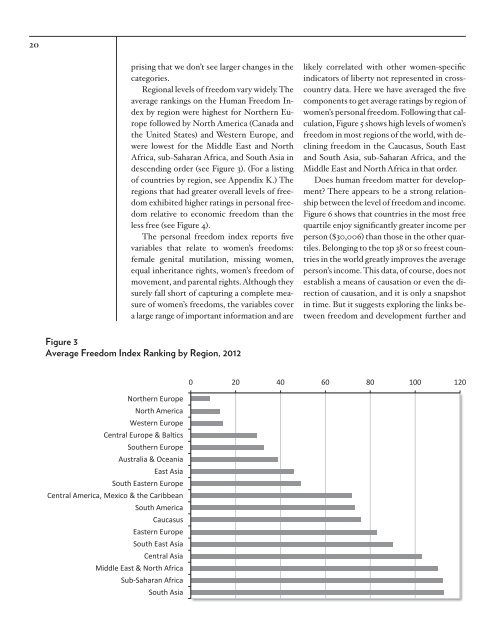P R E L I M I N A R Y R E P O R T
Rc8D1
Rc8D1
You also want an ePaper? Increase the reach of your titles
YUMPU automatically turns print PDFs into web optimized ePapers that Google loves.
20prising that we don’t see larger changes in thecategories.Regional levels of freedom vary widely. Theaverage rankings on the Human Freedom Indexby region were highest for Northern Europefollowed by North America (Canada andthe United States) and Western Europe, andwere lowest for the Middle East and NorthAfrica, sub-Saharan Africa, and South Asia indescending order (see Figure 3). (For a listingof countries by region, see Appendix K.) Theregions that had greater overall levels of freedomexhibited higher ratings in personal freedomrelative to economic freedom than theless free (see Figure 4).The personal freedom index reports fivevariables that relate to women’s freedoms:female genital mutilation, missing women,equal inheritance rights, women’s freedom ofmovement, and parental rights. Although theysurely fall short of capturing a complete measureof women’s freedoms, the variables covera large range of important information and arelikely correlated with other women-specificindicators of liberty not represented in crosscountrydata. Here we have averaged the fivecomponents to get average ratings by region ofwomen’s personal freedom. Following that calculation,Figure 5 shows high levels of women’sfreedom in most regions of the world, with decliningfreedom in the Caucasus, South Eastand South Asia, sub-Saharan Africa, and theMiddle East and North Africa in that order.Does human freedom matter for development?There appears to be a strong relationshipbetween the level of freedom and income.Figure 6 shows that countries in the most freequartile enjoy significantly greater income perperson ($30,006) than those in the other quartiles.Belonging to the top 38 or so freest countriesin the world greatly improves the averageperson’s income. This data, of course, does notestablish a means of causation or even the directionof causation, and it is only a snapshotin time. But it suggests exploring the links betweenfreedom and development further andFigure 3Average Freedom Index Ranking by Region, 20120 20 40 60 80 100 120Northern EuropeNorth AmericaWestern EuropeCentral Europe & BalticsSouthern EuropeAustralia & OceaniaEast AsiaSouth Eastern EuropeCentral America, Mexico & the CaribbeanSouth AmericaCaucasusEastern EuropeSouth East AsiaCentral AsiaMiddle East & North AfricaSub-Saharan AfricaSouth Asia


